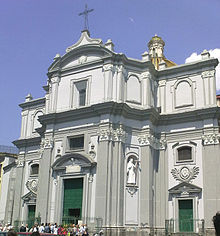Santa Maria della Sanità, Naples
| Basilica of Santa Maria della Sanità Basilica di Santa Maria della Sanità Template:It icon | |
|---|---|
 Façade of Santa Maria della Sanità. | |
| Religion | |
| Affiliation | Roman Catholic |
| District | Archdiocese of Naples |
| Ecclesiastical or organizational status | Minor basilica |
| Location | |
| Location | Naples, Campania, Italy |
| Geographic coordinates | 40°51′35″N 14°14′56″E / 40.8597°N 14.2490°E |
| Architecture | |
| Type | Church |
The Basilica of Santa Maria della Sanità is a basilica church located over the Catacombs of San Gaudioso, on a Piazza near where Via Sanità meets Via Teresa degli Scalzi, in the Rione of the Sanità, in Naples, Italy. The church is also called San Vincenzo or San Vincenzo della Sanità, due to the cult of an icon of San Vincenzo Ferrer, also called locally O' Monacone (the big monk).
History
The church was originally attached to a Dominican monastery founded in 1577. The church was built in a centralized Greek-cross plan from 1602 to 1613 using the architectural designs of Giuseppe Nuvolo.

The main altar is elevated and accessed via flanking Baroque-style spiraling staircases, all sheathed polychrome marble. The entrance to the catacombs is beneath the altar, which was elevated above the site of the original chapel at the site.[1]
The interior is decorated by painters such as:
- Giovanni Balducci (St Peter Martyr in right 2nd chapel)
- Giovanni Bernardino Azzolini (Rosary with small mysteries on the side and a Condemnation of the Albigensian Heretics in the large chapel and an Annuciation in 3rd chapel on left),
- Andrea Vaccaro (Marriage of St Catherine in right 4th chapel and St Catherine of Siena receives Stigmata in right 5th chapel)
- Girolamo de Magistro (Santa Lucia left large chapel)
- Giovanni Vincenzo Forli (Circumcision in large chapel on left)
- Luca Giordano (San Nicola with saints Ambrogio and Ludovico Beltrando below in the right first chapel, San Vicenzo in right 3rd chapel beside the original 5th century icon; also painted Virgin with St Rosa in left 2nd chapel, and a St Hyacinth a cui porge una scritta "gaude fliimi hyacinte". He also painted a St Pius V with Dominican Saints)
- Gaspare Traversi (ovals in 3rd chapel on left)
- Agostino Beltrano and his wife Aniella de Rosa (San Raimondo da Pennafort in first chapel on left)
- Also works by Anna Maria Bova, Francesco Solimena, Giovanni Pisani, and Filippo Donzelli.[2]
The original church was connected to the veneration of San Gaudioso, a bishop of Abitina in the Roman province of Africa, who died in Naples in c.451 after being set adrift from the north African coast by the Vandal King Genseric. In the 1500s, a 6th-century image of the Madonna and Child was uncovered here, and led to the establishment of this church.
The marble pulpit dates from 1677 to 1705. The organ, now in disuse, dates from the early 1700s.[3]
